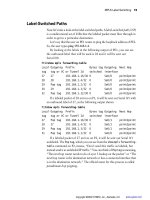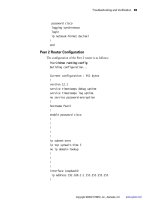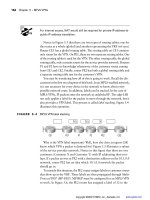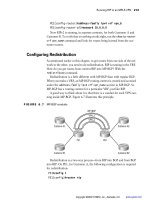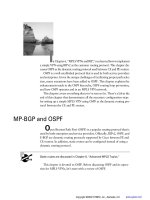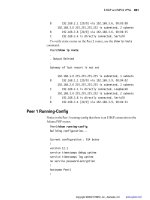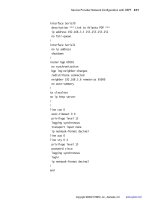Cisco press CCIP MPLS and VPN architectures
Bạn đang xem bản rút gọn của tài liệu. Xem và tải ngay bản đầy đủ của tài liệu tại đây (8.64 MB, 426 trang )
1
MPLS and VPN Architectures, CCIP™ Edition
By Ivan Pepelnjak CCIE #1354, Jim Guichard CCIE #2069
Publisher : Cisco Press
Pub Date : May 23, 2002
ISBN : 1-58705-081-1
Pages : 512
Multiprotocol Label Switching (MPLS) is an innovative technique for highperformance packet forwarding. The most widely deployed usage of MPLS today is
the enabling of Virtual Private Networks (VPNs). With the introduction of MPLSenabled VPNs, network designers can better scale their networks than with the
methods available in the past.
MPLS and VPN Architectures, CCIP Edition, is a practical guide to understanding,
designing, and deploying MPLS-based VPNs. This book covers MPLS theory and
configuration, network design issues, and one major MPLS application: MPLS-based
VPNs. The MPLS/VPN architecture and all its mechanisms are explained with
configuration examples, suggested design and deployment guidelines, and extensive
case studies.
This book has been revised from the first edition to include coverage of the CCIP
MPLS elective exam. New chapters have been added that cover MPLS
troubleshooting and MPLS/VPN troubleshooting; self-assessment questions at the
end of each chapter help you prepare for the CCIP MPLS elective exam. CCIP
candidates choosing to follow the MPLS elective will find this book to be a valuable
self-study component in their exam preparation.
•
•
•
•
•
•
Assists in preparation for the CCIP MPLS elective exam with detailed
technology coverage and review questions
Offers in-depth analysis of Multiprotocol Label Switching (MPLS) architecture
Helps you learn how MPLS scales to support tens of thousands of Virtual
Private Networks (VPNs)
Provides extensive case studies that guide you through the design and
deployment of real-world MPLS/VPN networks
Presents configuration examples and guidelines that assist you in configuring
MPLS on Cisco devices
Provides design and implementation options that help you build various VPN
topologies
MPLS and VPN Architectures, CCIP Edition, is part of a recommended study program
from Cisco Systems that includes training courses and materials from the Cisco
Learning Partner Program, hands-on experience, and Coursebooks and study guides
from Cisco Press. In order to learn more about instructor-led, e-learning, and handson instruction offered by Cisco Learning Partners worldwide, please visit
www.cisco.com/go/training.
2
About the Authors
Ivan Pepelnjak, CCIE #1354, is chief technology advisor of NIL Data
Communications (). He has over 10 years experience in designing,
installing, troubleshooting, and operating large service provider and enterprise WAN
and LAN networks. He joined NIL as technical director in 1991. His previous jobs
included LAN and SNA product development. He received his CCIE recognition in
1994 and was nominated for the best CCIE in Europe in 1996. Pepelnjak was also
one of the first experts in the world to become certified to teach Cisco Systems'
service-provider learning solutions.
Pepelnjak is the architect of NIL's Service Provider Academy program, one of the
architects of Cisco Systems' service provider curriculum, and the lead developer of
several service provider-focused courses covering Border Gateway Protocol (BGP),
Multiprotocol Label Switching (MPLS), and IP Quality of Service (QoS). He has
written two advanced IP routing books, MPLS and VPN Architectures and EIGRP
Network Design Solutions, both published by Cisco Press.
Jim Guichard, CCIE #2069, is a senior network design consultant within Global
Solutions Engineering at Cisco Systems. In recent years at Cisco, Jim has been
involved in the design, implementation, and planning of many large-scale WAN and
LAN networks. His breadth of industry knowledge, hands-on experience, and
understanding of complex internetworking architectures enable him to provide a
detailed insight into the new world of MPLS and its deployment. If you want to
contact Jim, he can be reached at
About the Technical Reviewers
Mark Gallo is a technical manager with America Online. His network certifications
include Cisco CCNP and Cisco CCDP. He has led several engineering groups
responsible for designing and implementing enterprise LANs and international IP
networks. While working for a major international telecommunications company, his
group was instrumental in developing an industry-leading service based on Cisco's
MPLS solution. He holds a bachelor's of science degree in electrical engineering from
the University of Pittsburgh. Mark resides in northern Virginia with his wife, Betsy,
and son, Paul.
Saeed Sardar is a software development and testing engineer working in the High
Speed Switching group for Cisco Systems, responsible for all aspects of IOS services
for catalyst 6000 family of products. His areas of specialty include Cisco Catalyst
Multilayer switches, Cisco routers, intelligent LAN super cards, network protocols,
and network operating systems.
3
Acknowledgments
Our special thanks go to Stefano Previdi from Cisco Systems. One of the MPLS
pioneers, he introduced us both to the intricacies of MPLS architecture and its
implementation in Cisco IOS. He was also kind enough to act as one of the reviewers
of the first edition of this book, making sure that the book thoroughly and correctly
covers all relevant MPLS aspects.
Every major project is a result of teamwork and this book is no exception. We'd like
to thank everyone who helped us in the writing process—the editorial and production
team from Cisco Press, including but not limited to Christopher Cleveland, John
Kane, and Amy Lewis, as well as our technical reviewers, Mark Gallo, and Saeed
Sardar.
Finally, this book would never have been written without the continuous support and
patience of our families, especially our wives, Sadie and Karmen.
Introduction
The original MPLS and VPN Architectures book was written at a time when MPLS VPN
was still an emerging technology. In the meantime, the technology has matured to
the stage where the majority of the forward-looking service providers use it to offer
VPN services to their clients. With the deployment of this technology in large-scale
production networks, the readers started to encounter the need for in-depth
discussion of MPLS and MPLS VPN monitoring and troubleshooting. The book was,
therefore, extended with two chapters covering MPLS troubleshooting and MPLS
VPN-specific troubleshooting.
Another significant change triggering the need for the second edition was the rollout
of official service provider training by Cisco Systems. Because the authors of the
book were closely involved in the training material development, the "Implementing
Cisco MPLS" course offered by Cisco Learning Solution Providers worldwide closely
maps to the structure of this book, making the book an excellent companion to the
course.
The service-provider training rollout was accompanied with a new service-provider
specific career certification schema, introducing two new career certifications: Cisco
Certified Internetwork Professional (CCIP), and the Cisco Certified Internetwork
Expert—Communications and Services (CCIE C&S).
CCIP Certification Process
To meet a growing need for skills and talent from the telecommunications sector,
Cisco Systems has formulated a new certification track: Communications and
Services. The certifications identify talented professionals who can plan, design,
implement, or operate New World service provider networks. Certification exams
qualify individuals who demonstrate competencies in infrastructure or access
solutions in a Cisco end-to-end. The certification track includes the professional-level
certification (CCIP) and the expert-level certification (CCIE C&S). The associate-level
4
certification (Cisco Certified Networking Associate—CCNA) is shared with the other
certification tracks.
The CCIP certification process is similar to the Cisco Certified Networking Professional
(CCNP) certification process. The student must gain in-depth knowledge in a variety
of service provider-related technologies and pass a number of written exams
administered by Prometrics or VUE testing centers. Contrary to the CCNP
certification, the CCIP certification consists of several mandatory exams and an
elective track, which covers a service-provider technology selected by the CCIP
candidate. These technologies range from MPLS VPN to optical, packet telephony, or
cable; new technologies are constantly being added.
The entire CCIP certification path with the MPLS VPN technology being chosen as the
elective technology is summarized in the following table, which lists all exams,
corresponding recommended training, and recommended Cisco Press books.
Topic
Exam
Recommended
Training
Recommended Books
from Cisco Press
Advanced IP
Routing
640-900 BSCI
Building Scalable Cisco
Internetworks (BSCI)
Routing TCP/IP, Volume I
and II
Configuring BGP on
Cisco Routers (CBCR)
Large-Scale IP Network
Solutions
Configuring IS-IS on
Cisco Routers (CISIS)
Building Scalable Cisco
Networks
Internet Routing
Architectures, Second
Edition
IS-IS Network Design
Solutions
IP Services
640-905
QoS+MCAST
Implementing Cisco
Multicast (MCAST)
Enhanced IP Services for
Cisco Networks
Implementing Cisco QoS
(QoS)
IP Quality of Service
Developing IP Multicast
Networks
MPLS VPN
Elective
640-910 MPLS
Implementing Cisco
MPLS
MPLS and VPN
Architectures
The knowledge needed to pass the required exams can be gained in a number of
different ways, depending on your learning preferences:
•
•
•
Traditional instructor-led training with a Cisco Learning Solution Provider
Self-paced training through Web-based training (WBT) modules
Reading Cisco Press books
5
In all cases, the theory gained by reading the recommended books or following
recommended training is best augmented with hands-on exercises. The exercises are
usually part of instructor-led classroom training. If you decide to follow any other
learning method, you can also perform the lab exercises in a remote lab
environment. Currently, the only provider offering CCIP-level remote lab exercises is
NIL Data Communications (www.ccip.com).
Goals and Methods
The most important and somewhat obvious goal of this book is to help you pass the
MPLS elective exam (640-910) of the CCIP certification track. In fact, if the primary
objective of this book were different, the book's title would be misleading; however,
the methods used in this book to help you pass the MPLS elective exam are designed
to also make you much more knowledgeable about how to do your job. Although this
book has many questions to help you prepare for the actual exam, they are not used
to simply make you memorize as many questions and answers as you possibly can.
This book is designed to help you discover the exam topics that you need to review
in more depth, to help you fully understand and remember those details, and to help
you prove to yourself that you have retained your knowledge of those topics. So, this
book does not try to help you pass by memorization but helps you truly learn and
understand the topics. The MPLS elective exam covers an extremely important
service-provider technology, and the knowledge contained within is vitally important
if you want to consider yourself a truly skilled service provider-focused engineer or
specialist. This book would do you a disservice if it didn't attempt to help you learn
the material. To that end, the book helps you pass the MPLS elective exam by using
the following methods:
•
•
•
Helping you discover which test topics you have not mastered
Providing explanations and information to fill in your knowledge gaps
Supplying exercises and scenarios that enhance your ability to recall and
deduce the answers to test questions
Who Should Read This Book?
This book is not designed to be a general networking topics book, although it can be
used for that purpose. This book is intended to increase tremendously your chances
of passing the CCIP MPLS elective exam. Although other objectives can be achieved
from using this book, the book is written with one goal in mind: to help you pass the
exam.
So why should you want to pass the CCIP MPLS elective exam? Because it's the last
step toward getting the CCIP certification—no small feat in itself. Why would you
want the CCIP? In addition to a raise, a promotion, and recognition, you can use it to
enhance your resume; to demonstrate that you are serious about continuing the
learning process and that you're not content to rest on your laurels; to please your
reseller-employer, who needs more certified employees for a higher discount from
Cisco; or one of many other reasons.
6
Strategies for Exam Preparation
The strategy you use for the MPLS elective exam might be slightly different than
strategies other readers use, mainly based on the skills, knowledge, and experience
you have already obtained. For instance, if you have attended the Cisco's MPLS
course, you might take a different approach than someone who learned the MPLS
basics through on-the-job training.
Regardless of the strategy you use or the background you have, this book is
designed to help you get to the point where you can pass the exam with the least
amount of time required. For instance, there is no need for you to practice or read
about MPLS architecture if you fully understand it already. However, many people
like to make sure that they truly know a topic and thus read over material that they
already know. Several book features help you gain the confidence that you know
material already and help you know which topics you need to study more.
7
How This Book Is Organized
Although this book could be read cover-to-cover, it is designed to be flexible and
allow you to move easily between chapters and sections of chapters to cover only the
material that you need more work with. The book is split in two parts:
•
•
Part I, "MPLS Technology and Configuration"— This part describes
overall MPLS architecture, its implementation on Cisco IOS in both framemode and cell-mode (ATM) scenarios, as well as the advanced MPLS topics
and MPLS troubleshooting.
Part II, "MPLS-based Virtual Private Networks"— This part describes
various VPN implementation options, the position of MPLS VPN technology in
the VPN solution space, and MPLS VPN architecture and operation, as well as
advanced configuration, deployment, and troubleshooting topics.
Individual chapters in the book cover the following topics:
•
•
•
•
•
•
•
•
•
Chapter 1, "Multiprotocol Label Switching (MPLS) Architecture
Overview"— This chapter describes the limitations of traditional IP routing
and MPLS as the solution to these shortcomings. It also describes end-to-end
MPLS architecture and architecture of individual label switch routers (LSR).
The chapter concludes with discussion of how various MPLS-based
applications (for example, MPLS VPN, MPLS Traffic Engineering, or MPLS
Multicast) can coexist on the same LSR.
Chapter 2, "Frame-mode MPLS Operation"— This chapter describes the
configuration and monitoring of frame-mode MPLS on Cisco IOS devices.
Chapter 3, "Cell-mode MPLS Operation"— This chapter describes the
configuration and monitoring of ATM-based cell-mode MPLS on Cisco IOS
devices. The chapter covers router configuration and ATM switch configuration
for IOS-based ATM switches.
Chapter 4, "Running Frame-mode MPLS Across Switched WAN
Media"— Sometimes, you need to run MPLS over a public frame-relay or
ATM network. This chapter gives you the configuration knowledge needed to
deploy MPLS in these environments.
Chapter 5, "Advanced MPLS Topics"— This chapter covers advanced MPLS
topics, including conditional label advertising, and loop prevention and
detection in MPLS. The chapter also covers effects of IP address
summarization on proper MPLS operation.
Chapter 6, "MPLS Migration and Configuration Case Study"— This
chapter presents a typical migration case study: a large Internet service
provider (ISP) migrating from a pure IP backbone to an MPLS backbone.
Chapter 7, "MPLS Troubleshooting"— This chapter describes detailed
step-by-step troubleshooting of MPLS networks.
Chapter 8, "Virtual Private Network (VPN) Implementation Options"—
This chapter starts with a definition of a Virtual Private Network and describes
the differences between two fundamental VPN models: the overlay VPN
versus the peer-to-peer VPN model. The chapter continues with the
presentation of various technologies available to implement overlay or peerto-peer VPN models.
Chapter 9, "MPLS/VPN Architecture Overview"— Based on the
discussion of VPN architectures in the previous chapter, this chapter positions
MPLS VPN technology in the overall VPN solutions space and describes the
8
•
•
•
•
•
•
•
•
VPN route propagation and VPN packet forwarding inside the MPLS VPN
network.
Chapter 10, "MPLS/VPN Architecture Operation"— Building on the MPLS
VPN architecture presented in the previous chapter, this chapter discusses the
in-depth details of MPLS VPN architecture and its implementation on Cisco
IOS.
Chapter 11, "Provider Edge (PE) to Customer Edge (CE) Connectivity
Options"— This chapter describes various means to exchange routing
information between Provider Edge (PE) routers and Customer Edge (CE)
routers, covering static routes, Routing Information Protocol (RIP), Open
Shortest Path First (OSPF), and Border Gateway Protocol (BGP).
Chapter 12, "Advanced MPLS VPN Topologies"— This chapter describes
advanced topologies that can be implemented within the MPLS VPN
architecture, ranging from overlapping VPN topology through central services
topology to emulation of hub-and-spoke topology in the MPLS VPN
environment.
Chapter 13, "Advanced MPLS VPN Topics"— This chapter covers topics
needed for successful large-scale MPLS VPN deployment. Topics covered in
this chapter include MPLS VPN scaling and convergence tuning, as well as
deployment of partitioned route reflectors and BGP confederations in the
MPLS VPN backbone. The chapter concludes with the description of various
ways to integrate VPN services with Internet access in MPLS VPN
environment.
Chapter 14, "Guidelines for Deployment of MPLS VPN" — This chapter
gives you detailed MPLS VPN design and deployment guidelines.
Chapter 15, "Carrier's Carrier and Inter-provider VPN Solutions"—
This chapter covers two inter-provider MPLS VPN models: the Carrier's Carrier
model, in which one service provider deploys its MPLS VPN services over
MPLS infrastructure of another service provider, and the Inter-provider VPN
model, in which two service providers provide end-to-end MPLS VPN services
in a peer-to-peer model.
Chapter 16, "IP Tunneling to MPLS/VPN Migration Case Study"— This
chapter describes a typical migration case study. A customer that has
implemented VPN services with IP tunnels over public IP infrastructure is
migrated to more secure MPLS VPN infrastructure.
Chapter 17, "MPLS VPN Troubleshooting"— This chapter builds on
Chapter 7, "MPLS Troubleshooting," and describes the in-depth details of
control-plane and data-plane MPLS VPN troubleshooting.
9
Icons Used in This Book
10
Part I: MPLS Technology and
Configuration
Chapter 1 Multiprotocol Label Switching (MPLS) Architecture Overview
Chapter 2 Frame-mode MPLS Operation
Chapter 3 Cell-mode MPLS Operation
Chapter 4 Running Frame-mode MPLS Across Switched WAN Media
Chapter 5 Advanced MPLS Topics
Chapter 6 MPLS Migration and Configuration Example
Chapter 1. Multiprotocol Label
Switching (MPLS) Architecture
Overview
This chapter includes the following topics:
•
•
•
Scalability and Flexibility of IP-based Forwarding
Multiprotocol Label Switching (MPLS) Introduction
Other MPLS Applications
Traditional IP packet forwarding analyzes the destination IP address contained in the
network layer header of each packet as the packet travels from its source to its final
destination. A router analyzes the destination IP address independently at each hop
in the network. Dynamic routing protocols or static configuration builds the database
needed to analyze the destination IP address (the routing table). The process of
implementing traditional IP routing also is called hop-by-hop destination-based
unicast routing.
Although successful, and obviously widely deployed, certain restrictions, which have
been realized for some time, exist for this method of packet forwarding that diminish
its flexibility. New techniques are therefore required to address and expand the
functionality of an IP-based network infrastructure.
This first chapter concentrates on identifying these restrictions and presents a new
architecture, known as Multiprotocol Label Switching (MPLS), that provides solutions
to some of these restrictions. The following chapters focus first on the details of the
MPLS architecture in a pure router environment, and then in a mixed router/ATM
switch environment.
11
Scalability and Flexibility of IP-based Forwarding
To understand all the issues that affect the scalability and the flexibility of traditional
IP packet forwarding networks, you must start with a review of some of the basic IP
forwarding mechanisms and their interaction with the underlying infrastructure
(local- or wide-area networks). With this information, you can identify any
drawbacks to the existing approach and perhaps provide alternative ideas on how
this could be improved.
Network Layer Routing Paradigm
Traditional network layer packet forwarding (for example, forwarding of IP packets
across the Internet) relies on the information provided by network layer routing
protocols (for example, Open Shortest Path First [OSPF] or Border Gateway Protocol
[BGP]), or static routing, to make an independent forwarding decision at each hop
(router) within the network. The forwarding decision is based solely on the
destination unicast IP address. All packets for the same destination follow the same
path across the network if no other equal-cost paths exist. Whenever a router has
two equal-cost paths toward a destination, the packets toward the destination might
take one or both of them, resulting in some degree of load sharing.
NOTE
Enhanced Interior Gateway Routing Protocol (EIGRP) also supports non–
equal-cost load sharing although the default behavior of this protocol is
equal-cost. You must configure EIGRP variance for non–equal-cost load
balancing. Please see EIGRP Network Design Solutions (ISBN 1-57870-1651) from Cisco Press for more details on EIGRP.
Load sharing in Cisco IOS can be performed on a packet-by-packet or
source-destination-pair basis (with Cisco Express Forwarding [CEF]
switching) or on a destination basis (most of the other switching methods).
Routers perform the decision process that selects what path a packet takes. These
network layer devices participate in the collection and distribution of network-layer
information, and perform Layer 3 switching based on the contents of the network
layer header of each packet. You can connect the routers directly by point-to-point
links or local-area networks (for example, shared hub or MAU), or you can connect
them by LAN or WAN switches (for example, Frame Relay or ATM switches). These
Layer 2 (LAN or WAN) switches unfortunately do not have the capability to hold
Layer 3 routing information or to select the path taken by a packet through analysis
of its Layer 3 destination address. Thus, Layer 2 (LAN or WAN) switches cannot be
involved in the Layer 3 packet forwarding decision process. In the case of the WAN
environment, the network designer has to establish Layer 2 paths manually across
the WAN network. These paths then forward Layer 3 packets between the routers
that are connected physically to the Layer 2 network.
12
LAN Layer 2 paths are simple to establish—all LAN switches are transparent to the
devices connected to them. The WAN Layer 2 path establishment is more complex.
WAN Layer 2 paths usually are based on a point-to-point paradigm (for example,
virtual circuits in most WAN networks) and are established only on request through
manual configuration. Any routing device (ingress router) at the edge of the Layer 2
network that wants to forward Layer 3 packets to any other routing device (egress
router) therefore needs to either establish a direct connection across the network to
the egress device or send its data to a different device for transmission to the final
destination.
Consider, for example, the network shown in Figure 1-1.
Figure 1-1. Sample IP Network Based on ATM Core
The network illustrated in Figure 1-1 is based on an ATM core surrounded by routers
that perform network layer forwarding. Assuming that the only connections between
the routers are the ones shown in Figure 1-1, all the packets sent from San Francisco
to or through Washington must be sent to the Dallas router, where they are analyzed
and sent back over the same ATM connection in Dallas to the Washington router.
This extra step introduces delay in the network and unnecessarily loads the CPU of
the Dallas router as well as the ATM link between the Dallas router and the adjacent
ATM switch in Dallas.
To ensure optimal packet forwarding in the network, an ATM virtual circuit must exist
between any two routers connected to the ATM core. Although this might be easy to
achieve in small networks, such as the one in Figure 1-1, you run into serious
scalability problems in large networks where several tens or even hundreds of
routers connect to the same WAN core.
13
The following facts illustrate the scalability problems you might encounter:
•
Every time a new router is connected to the WAN core of the network, a
virtual circuit must be established between this router and any other router, if
optimal routing is required.
Note
In Frame Relay networks, the entire configuration could be done
within the Layer 2 WAN core and the routers would find new
neighbors and their Layer 3 protocol addresses through the use of
LMI and Inverse ARP. This also is possible on an ATM network
through the use of Inverse ARP, which is enabled by default when a
new PVC is added to the configuration of the router, and ILMI, which
can discover PVCs dynamically that are configured on the local ATM
switch.
•
With certain routing protocol configurations, every router attached to the
Layer 2 WAN core (built with ATM or Frame Relay switches) needs a dedicated
virtual circuit to every other router attached to the same core. To achieve the
desired core redundancy, every router also must establish a routing protocol
adjacency with every other router attached to the same core. The resulting
full-mesh of router adjacencies results in every router having a large number
of routing protocol neighbors, resulting in large amounts of routing traffic. For
example, if the network runs OSPF or IS-IS as its routing protocol, every
router propagates every change in the network topology to every other router
connected to the same WAN backbone, resulting in routing traffic proportional
to the square of the number of routers.
Note
Configuration tools exist in recent Cisco IOS implementations of ISIS and OSPF routing protocols that allow you to reduce the routing
protocol traffic in the network. Discussing the design and the
configuration of these tools is beyond the scope of this book. (Any
interested reader should refer to the relevant Cisco IOS
configuration guides.)
•
Provisioning of the virtual circuits between the routers is complex, because
it's very hard to predict the exact amount of traffic between any two routers
in the network. To simplify the provisioning, some service providers just opt
for lack of service guarantee in the network—zero Committed Information
14
Rate (CIR) in a Frame Relay network or Unspecified Bit Rate (UBR)
connections in an ATM network.
The lack of information exchange between the routers and the WAN switches was not
an issue for traditional Internet service providers that used router-only backbones or
for traditional service providers that provided just the WAN services (ATM or Frame
Relay virtual circuits). There are, however, several drivers that push both groups
toward mixed backbone designs:
•
•
•
Traditional service providers are asked to offer IP services. They want to
leverage their investments and base these new services on their existing WAN
infrastructure.
Internet service providers are asked to provide tighter quality of service
(QoS) guarantees that are easier to meet with ATM switches than with
traditional routers.
The rapid increase in bandwidth requirements prior to the introduction of
optical router interfaces forced some large service providers to start relying
on ATM technology because the router interfaces at that time did not provide
the speeds offered by the ATM switches.
It is clear, therefore, that a different mechanism must be used to enable the
exchange of network layer information between the routers and the WAN switches
and to allow the switches to participate in the decision process of forwarding packets
so that direct connections between edge routers are no longer required.
Differentiated Packet Servicing
Conventional IP packet forwarding uses only the IP destination address contained
within the Layer 3 header within a packet to make a forwarding decision. The hopby-hop destination-only paradigm used today prevents a number of innovative
approaches to network design and traffic-flow optimization. In Figure 1-2, for
example, the direct link between the San Francisco core router and the Washington
core router forwards the traffic entering the network in any of the Bay Area Pointsof-Presence (POPs), although that link might be congested and the links from San
Francisco to Dallas and from Dallas to Washington might be only lightly loaded.
Figure 1-2. Sample Network that Would Benefit from Traffic
Engineering
15
Although certain techniques exist to affect the decision process, such as Policy Based
Routing (PBR), no single scalable technique exists to decide on the full path a packet
takes across the network to its final destination. In the network shown in Figure 1-2,
the policy-based routing must be deployed on the San Francisco core router to divert
some of the Bay Area to Washington traffic toward Dallas. Deploying such features
as PBR on core routers could severely reduce the performance of a core router and
result in a rather unscalable network design. Ideally, the edge routers (for example,
the Santa Clara POP in Figure 1-2) can specify over which core links the packets
should flow.
NOTE
Several additional issues are associated with policy-based routing. PBR can
lead easily to forwarding loops as a router configured with PBR deviates
from the forwarding path learned from the routing protocols. PBR also is
hard to deploy in large networks; if you configure PBR at the edge, you
must be sure that all routers in the forwarding path can make the same
route selection.
Because most major service providers deploy networks with redundant paths, a
requirement clearly exists to allow the ingress routing device to be capable of
deciding on packet forwarding, which affects the path a packet takes across the
network, and of applying a label to that packet that indicates to other devices which
path the packet should take.
This requirement also should allow packets that are destined for the same IP network
to take separate paths instead of the path determined by the Layer 3 routing
protocol. This decision also should be based on factors other than the destination IP
address of the packet, such as from which port the packet was learned, what quality
of service level the packet requires, and so on.
16
Independent Forwarding and Control
With conventional IP packet forwarding, any change in the information that controls
the forwarding of packets is communicated to all devices within the routing domain.
This change always involves a period of convergence within the forwarding
algorithm.
A mechanism that can change how a packet is forwarded, without affecting other
devices within the network, certainly is desirable. To implement such a mechanism,
forwarding devices (routers) should not rely on IP header information to forward the
packet; thus, an additional label must be attached to a forwarded packet to indicate
its desired forwarding behavior. With the packet forwarding being performed based
on labels attached to the original IP packets, any change within the decision process
can be communicated to other devices through the distribution of new labels.
Because these devices merely forward traffic based on the attached label, a change
should be able to occur without any impact at all on any devices that perform packet
forwarding.
External Routing Information Propagation
Conventional packet forwarding within the core of an IP network requires that
external routing information be advertised to all transit routing devices. This is
necessary so that packets can be routed based on the destination address that is
contained within the network layer header of the packet. To continue the example
from previous sections, the core routers in Figure 1-2 would have to store all
Internet routes so that they could propagate packets between Bay Area customers
and a peering point in MAE-East.
NOTE
You might argue that each major service provider also must have a peering
point somewhere on the West coast. That fact, although true, is not
relevant to this discussion because you can always find a scenario where a
core router with no customers or peering partners connected to it needs
complete routing information to be able to forward IP packets correctly.
This method has scalability implications in terms of route propagation, memory
usage, and CPU utilization on the core routers, and is not really a required function if
all you want to do is pass a packet from one edge of the network to another.
A mechanism that allows internal routing devices to switch the packets across the
network from an ingress router toward an egress router without analyzing network
layer destination addresses is an obvious requirement.
17
Multiprotocol Label Switching (MPLS)
Introduction
Multiprotocol Label Switching (MPLS) is an emerging technology that aims to address
many of the existing issues associated with packet forwarding in today's
Internetworking environment. Members of the IETF community worked extensively
to bring a set of standards to market and to evolve the ideas of several vendors and
individuals in the area of label switching. The IETF document draft-ietf-mplsframework contains the framework of this initiative and describes the primary goal
as follows:
The primary goal of the MPLS working group is to standardize a base
technology that integrates the label swapping forwarding paradigm
with network layer routing. This base technology (label swapping) is
expected to improve the price/performance of network layer routing,
improve the scalability of the network layer, and provide greater
flexibility in the delivery of (new) routing services (by allowing new
routing services to be added without a change to the forwarding
paradigm).
NOTE
You can download IETF working documents from the IETF home page
(www.ietf.org). For MPLS working documents, start at the MPLS home page
(www.ietf.org/html.charters/mpls-charter.html).
The MPLS architecture describes the mechanisms to perform label switching, which
combines the benefits of packet forwarding based on Layer 2 switching with the
benefits of Layer 3 routing. Similar to Layer 2 networks (for example, Frame Relay or
ATM), MPLS assigns labels to packets for transport across packet- or cell-based
networks. The forwarding mechanism throughout the network is label swapping, in
which units of data (for example, a packet or a cell) carry a short, fixed-length label
that tells switching nodes along the packets path how to process and forward the
data.
The significant difference between MPLS and traditional WAN technologies is the way
labels are assigned and the capability to carry a stack of labels attached to a packet.
The concept of a label stack enables new applications, such as Traffic Engineering,
Virtual Private Networks, fast rerouting around link and node failures, and so on.
Packet forwarding in MPLS is in stark contrast to today's connectionless network
environment, where each packet is analyzed on a hop-by-hop basis, its Layer 3
header is checked, and an independent forwarding decision is made based on the
information extracted from a network layer routing algorithm.
18
The architecture is split into two separate components: the forwarding component
(also called the data plane) and the control component (also called the control
plane). The forwarding component uses a label-forwarding database maintained by a
label switch to perform the forwarding of data packets based on labels carried by
packets. The control component is responsible for creating and maintaining labelforwarding information (referred to as bindings) among a group of interconnected
label switches. Figure 1-3 shows the basic architecture of an MPLS node performing
IP routing.
Figure 1-3. Basic Architecture of an MPLS Node Performing IP
Routing
Every MPLS node must run one or more IP routing protocols (or rely on static
routing) to exchange IP routing information with other MPLS nodes in the network.
In this sense, every MPLS node (including ATM switches) is an IP router on the
control plane.
Similar to traditional routers, the IP routing protocols populate the IP routing table.
In traditional IP routers, the IP routing table is used to build the IP forwarding cache
(fast switching cache in Cisco IOS) or the IP forwarding table (Forwarding
Information Base [FIB] in Cisco IOS) used by Cisco Express Forwarding (CEF).
In an MPLS node, the IP routing table is used to determine the label binding
exchange, where adjacent MPLS nodes exchange labels for individual subnets that
19
are contained within the IP routing table. The label binding exchange for unicast
destination-based IP routing is performed using the Cisco proprietary Tag
Distribution Protocol (TDP) or the IETF-specified Label Distribution Protocol (LDP).
The MPLS IP Routing Control process uses labels exchanged with adjacent MPLS
nodes to build the Label Forwarding Table, which is the forwarding plane database
that is used to forward labeled packets through the MPLS network.
MPLS Architecture—The Building Blocks
As with any new technology, several new terms are introduced to describe the
devices that make up the architecture. These new terms describe the functionality of
each device and their roles within the MPLS domain structure.
The first device to be introduced is the Label Switch Router (LSR). Any router or
switch that implements label distribution procedures and can forward packets based
on labels falls under this category. The basic function of label distribution procedures
is to allow an LSR to distribute its label bindings to other LSRs within the MPLS
network. (Chapter 2, "Frame-mode MPLS Operation," discusses label distribution
procedures in detail.)
Several different types of LSR exist that are differentiated by what functionality they
provide within the network infrastructure. These different types of LSR are described
within the architecture as Edge-LSR, ATM-LSR, and ATM edge-LSR. The distinction
between various LSR types is purely architectural—a single box can serve several of
the roles.
An Edge-LSR is a router that performs either label imposition (sometimes also
referred to as push action) or label disposition (also called pop action) at the edge of
the MPLS network. Label imposition is the act of prepending a label, or a stack of
labels, to a packet in the ingress point (in respect of the traffic flow from source to
destination) of the MPLS domain. Label disposition is the reverse of this and is the
act of removing the last label from a packet at the egress point before it is forwarded
to a neighbor that is outside the MPLS domain.
Any LSR that has any non-MPLS neighbors is considered an Edge-LSR. However, if
that LSR has any interfaces that connect through MPLS to an ATM-LSR, it also is
considered to be an ATM edge-LSR. Edge-LSRs use a traditional IP forwarding table,
augmented with labeling information, to label IP packets or to remove labels from
labeled packets before sending them to non-MPLS nodes. Figure 1-4 shows the
architecture of an Edge-LSR.
Figure 1-4. Architecture of an Edge-LSR
20
An Edge-LSR extends the MPLS node architecture from Figure 1-3 with additional
components in the data plane. The standard IP forwarding table is built from the IP
routing table and is extended with labeling information. Incoming IP packets can be
forwarded as pure IP packets to non-MPLS nodes or can be labeled and sent out as
labeled packets to other MPLS nodes. The incoming labeled packets can be
forwarded as labeled packets to other MPLS nodes. For labeled packets destined for
non-MPLS nodes, the label is removed and a Layer 3 lookup (IP forwarding) is
performed to find the non-MPLS destination.
An ATM-LSR is an ATM switch that can act as an LSR. The Cisco Systems, Inc.
LS1010 and BPX family of switches are examples of this type of LSR. As you see in
the following chapters, the ATM-LSR performs IP routing and label assignment in the
control plane and forwards the data packets using traditional ATM cell switching
mechanisms on the data plane. In other words, the ATM switching matrix of an ATM
switch is used as a Label Forwarding Table of an MPLS node. Traditional ATM
switches, therefore, can be redeployed as ATM-LSRs through a software upgrade of
their control component.
Table 1-1 summarizes the functions performed by different LSR types. Please note
that any individual device in the network can perform more than one function. (For
example, it can be Edge-LSR and ATM edge-LSR at the same time.)
21
Table 1-1. Actions Performed by Various LSR Types
LSR
Type
Actions Performed by This LSR Type
LSR
Forwards labeled packets.
EdgeLSR
Can receive an IP packet, perform Layer 3 lookups, and impose a label
stack before forwarding the packet into the LSR domain.
Can receive a labeled packet, remove labels, perform Layer 3 lookups,
and forward the IP packet toward its next-hop.
ATM-LSR
Runs MPLS protocols in the control plane to set up ATM virtual circuits.
Forwards labeled packets as ATM cells.
ATM
edgeLSR
Can receive a labeled or unlabeled packet, segment it into ATM cells, and
forward the cells toward the next-hop ATM-LSR.
Can receive ATM cells from an adjacent ATM-LSR, reassemble these cells
into the original packet, and then forward the packet as a labeled or
unlabeled packet.
Label Imposition at the Network Edge
Label imposition has been described already as the act of prepending a label to a
packet as it enters the MPLS domain. This is an edge function, which means that
packets are labeled before they are forwarded to the MPLS domain.
To perform this function, an Edge-LSR needs to understand where the packet is
headed and which label, or stack of labels, it should assign to the packet. In
conventional Layer 3 IP forwarding, each hop in the network performs a lookup in
the IP forwarding table for the IP destination address contained in the Layer 3
header of the packet. It selects a next hop IP address for the packet at each iteration
of the lookup and eventually sends the packet out of an interface toward its final
destination.
NOTE
Some forwarding mechanisms, such as CEF, allow the router to associate
each destination prefix known in the routing table to the adjacent next hop
of the destination prefix, thus solving the recursive lookup problem. The
whole recursion is resolved while the router populates the cache or the
forwarding table and not when it has to forward packets.
Choosing the next hop for the IP packet is a combination of two functions. The first
function partitions the entire set of possible packets into a set of IP destination
prefixes. The second function maps each IP destination prefix to an IP next-hop
address. This means that each destination in the network is reachable by one path in
respect to traffic flow from one ingress device to the destination egress device.
(Multiple paths might be available if load balancing is performed using equal-cost
paths or unequal-cost paths as with some IGP protocols, such as Enhanced IGRP.)
22
Within the MPLS architecture, the results of the first function are known as
Forwarding Equivalence Classes (FECs). These can be visualized as describing a
group of IP packets that are forwarded in the same manner, over the same path,
with the same forwarding treatment.
NOTE
A Forwarding Equivalence Class might correspond to a destination IP
subnet but also might correspond to any traffic class that the Edge-LSR
considers significant. For example, all interactive traffic toward a certain
destination or all traffic with a certain value of IP precedence might
constitute an FEC. As another example, an FEC can be a subset of the BGP
table, including all destination prefixes reachable through the same exit
point (egress BGP router).
With conventional IP forwarding, the previously described packet processing is
performed at each hop in the network. However, when MPLS is introduced, a
particular packet is assigned to a particular FEC just once, and this is at the edge
device as the packet enters the network. The FEC to which the packet is assigned is
then encoded as a short fixed-length identifier, known as a label.
When a packet is forwarded to its next hop, the label is prepended already to the IP
packet so that the next device in the path of the packet can forward it based on the
encoded label rather than through the analysis of the Layer 3 header information.
Figure 1-5 illustrates the whole process of label imposition and forwarding.
Figure 1-5. MPLS Label Imposition and Forwarding
23
NOTE
The actual packet forwarding between the Washington and MAE-East
routers might be slightly different from the one shown in Figure 1-5 due to
a mechanism called penultimate hop popping (PHP). Penultimate hop
popping arguably might improve the switching performance but does not
impact the logic of label switching. Chapter 2 covers this mechanism and its
implications.
MPLS Packet Forwarding and Label Switched Paths
Each packet enters an MPLS network at an ingress LSR and exits the MPLS network
at an egress LSR. This mechanism creates what is known as a Label Switched Path
(LSP), which essentially describes the set of LSRs through which a labeled packet
must traverse to reach the egress LSR for a particular FEC. This LSP is unidirectional,
which means that a different LSP is used for return traffic from a particular FEC.
The creation of the LSP is a connection-oriented scheme because the path is set up
prior to any traffic flow. However, this connection setup is based on topology
information rather than a requirement for traffic flow. This means that the path is
created regardless of whether any traffic actually is required to flow along the path
to a particular set of FECs.
As the packet traverses the MPLS network, each LSR swaps the incoming label with
an outgoing label, much like the mechanism used today within ATM where the
24
VPI/VCI is swapped to a different VPI/VCI pair when exiting the ATM switch. This
continues until the last LSR, known as the egress LSR, is reached.
Each LSR keeps two tables, which hold information that is relevant to the MPLS
forwarding component. The first, known in Cisco IOS as the Tag Information Base
(TIB) or Label Information Base (LIB) in standard MPLS terms, holds all labels
assigned by this LSR and the mappings of these labels to labels received from any
neighbors. These label mappings are distributed through the use of label-distribution
protocols, which Chapter 2 discusses in more detail.
Just as multiple neighbors can send labels for the same IP prefix but might not be
the actual IP next hop currently in use in the routing table for the destination, not all
the labels within the TIB/LIB need to be used for packet forwarding. The second
table, known in Cisco IOS as the Tag Forwarding Information Base (TFIB) or Label
Forwarding Information Base (LFIB) in MPLS terms, is used during the actual
forwarding of packets and holds only labels that are in use currently by the
forwarding component of MPLS.
NOTE
Label Forwarding Information Base is the MPLS equivalent of the switching
matrix of an ATM switch.
Using Cisco IOS terms and Cisco Express Forwarding (CEF) terminology, the EdgeLSR architecture in Figure 1-4 can be redrawn as shown in Figure 1-6. (Edge-LSR
was chosen because its function is a superset of non–Edge-LSR.)
Figure 1-6. Edge-LSR Architecture Using Cisco IOS Terms
25

